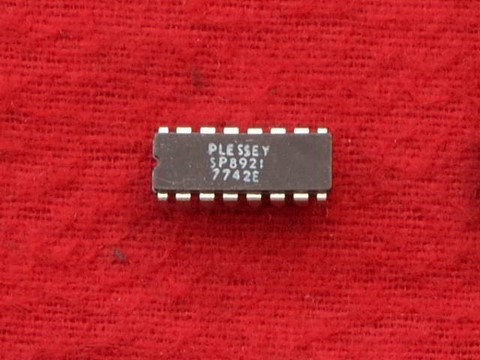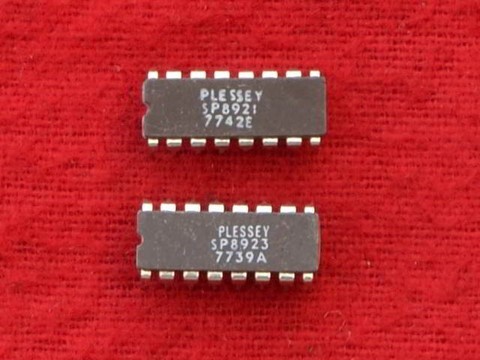SP8921 Synthesiser
Features
- Low External Component Count
- Binary (SP8922) or BCD (SP8923) Channel Setting
- Internal Pulldowns on Channel Inputs
- Integral 10.24MHz Crystal Oscillator with Buffered O/P
- 10.695M Hz IF Offset for Double Conversion
- 455 kHz IF offset for Single Conversion
- No Mixing or Prescaling Required between VCO and Synthesiser I/P
- Digital Phase/Frequency Comparator has Source and Sink O/Ps
- Lock Detect O/P
- 5V Supply Rail
- Low Power: 225mW Typ. (SP8921)
- 225mW Typ. (SP8922)
- 325mW Typ. (SP8923)
Description
Recognising the different requirements of citizens' band transceiver manufacturers, Plessey Semiconductors have developed a range of integrated circuits for 40-channel CB. This datasheet describes three of these:
SP8921, SP8922 and SP8923.
The devices are designed for use in pairs. SP8922 and SP8921 incorporate all the functions for a synthesised local oscillator with binary-coded channel entry; the SP8923/21 pair offering similar facilities but with BCD channel entry.
The synthesisers are partitioned into two parts as shown in Figs. 2 and 3. The SP8922 and SP8923 contain a preamplifier followed by a fixed divide by four prescaler. The amplifier input will accept a signal at a frequency up to 30M Hz. The input is a high impedance and requires an AC coupled source which is achieved by a series capacitor. The prescaler is followed by seven bits of programmable division. In the SP8922, these seven bits are programmed from the six binary inputs, as shown in Table 1, plus the 5kHz program input.
The SP8923 is programmed by seven BCD channel inputs (see Table 2), the 40 input codes being converted by a decoding matrix to the appropriate citizens' band frequencies.
A receive/transmit (R/T) input is provided on both SP8922 and SP8923 to give an offset of 91 counts (corresponding to -455kHz) when the receive mode is selected.
Clock and preset outputs to the SP8921 are provided by SP8922 and SP8923, which in turn accept a recognition signal from the SP8921.
Pin 9 on the SP8923 is an Emergency Channel Select output, which gives a low output whenever channel 9, or a non-permitted channel, is selected. When this out-
put is low, the synthesiser programs to channel 9.
The device common to both sets, SP8921, contains the six most significant bits of the programmable counter, a 10.24MHz crystal oscillator maintaining circuit, a 2a13 fixed divider, and a digital phase/frequency comparator. The six bits of the programmable counter have a fixed preset code which, combined with the variable code of the SP8922 or SP8923, give the total count required to select the 40 citizens' band frequencies. The R/T input to the SP8921 gives an offset in the programmable count of minus 2048 (corresponding to -10.24 MHz) when in the receive mode.
The crystal oscillator has a direct emitter follower output which may be used as an input to the second mixer in a double conversion transceiver as shown in Fig. 4. The oscillator is connected internally to the fixed divider, which gives an output reference frequency of 1.25kHz with a 10.24MHz crystal. The phase/frequency comparator has two outputs which may be used to drive a variety of charge pump filter circuits as shown in Figs. 7 through 10. There is also a 'lock detect' output which requires an external filter as shown in Figs. 2 and 3.
The frequencies available from the SP8922/1 and SP8923/1 when connected in a synthesiser loop are shown in Tables 1 and 2 respectively.

